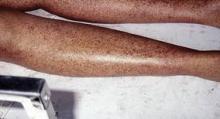LAS VEGAS - Travelers returning from international destinations may bring home with them a variety of rash-causing illnesses that range from the self-limited to the life-threatening, according to Dr. Rachel L. Chin.
The most common dermatologic conditions in ill returned travelers are arthropod-related ones (accounting for 31%), pyodermas (13%), soil-related ones (11%), and animal-related ones (9%) (Int. J. Infect. Dis. 2008;12:593-602), she told attendees of the annual meeting of the American College of Emergency Physicians.
In sorting out the many possible etiologies of a rash in the traveler returning home, "use the mnemonic TRIPS," recommended Dr. Chin, who is a professor of emergency medicine at the University of California, San Francisco.
It stands for time of travel (the time of year and itinerary), region visited (and associated risks and any specific exposures), incubation period (a range, calculated from the first day and last day of travel to symptom onset), prophylaxis taken (which helps rule out possibilities), and signs and symptoms.
In addition, she noted that the Geosentinel Surveillance Network (www.istm.org/geosentinel/main.html) can be an invaluable aid for staying aware of existing and emerging health threats in various parts of the world.
"It's the largest collaborative effort in travel medicine, [involving] the CDC and the International Society of Travel Medicine," she explained. "They monitor travel and tropical medicine clinics on six continents."
Dr. Chin offered some tips for diagnosing and managing specific travel-related rashes that emergency physicians may encounter in their practice, although several of these rashes can also be acquired domestically.
Acute HIV Infection
Clinicians' vigilance for rashes due to sexually transmitted diseases should be especially high for travelers returning from sex tourism destinations, such as Pattaya, Thailand, and Angeles City, Philippines, she noted.
"If you have a patient who is back from any of these destinations with a new rash, ask for a detailed sexual history and send an HIV test," Dr. Chin recommended.
Importantly, the rapid test for HIV used in emergency departments is for antibodies, which are usually not detectable in acute infection, the time when the morbilliform or maculopapular rash often appears.
"Send the rapid test first," she advised. "If it's negative, send for an RNA test if you have a new rash [in a patient returning] from those destinations."
Dengue Fever
A mosquito-borne illness having an incubation period of up to 2 weeks, dengue produces fever, fatigue, myalgia, arthralgia, and severe headache (often described as retro-orbital pain), followed by a generalized maculopapular rash with scattered petechiae.
Laboratory testing often shows leukopenia, thrombocytopenia, and elevated transaminitis, according to Dr. Chin. Patients are typically not as ill as one would expect with meningococcemia, which may also be in the differential.
"Dengue is often a clinical diagnosis, and you confirm it with a rise in serum antibody titers and, of course, they have traveled in an endemic area," she said, such as certain parts of Central and South America and Africa.
"The treatment for dengue is supportive," Dr. Chin noted; once the rash appears, the fever begins to subside and patients begin to feel better.
"You want to avoid NSAIDs because of the thrombocytopenia that they have and the increased risk of bleeding," she cautioned. "You can use Tylenol."
African Tick Bite Fever
One of the spotted fevers, African tick bite fever is a rickettsial illness seen in travelers exposed to wild animals through camping, hiking, or safaris in grass or scrubby areas. After an incubation period of about 1 week, travelers develop a fever and papulovesicular rash beginning on the trunk, sometimes accompanied by leukopenia or thrombocytopenia.
"An important diagnostic clue with this is the eschar," Dr. Chin pointed out. "It's a painless, necrotic or crusted lesion at the site of the tick bite with surrounding erythema." African tick bite fever can be definitively diagnosed with serology during the convalescent period. Affected patients should be treated with doxycycline. "A fast recovery is often diagnostic with this rickettsial disease – we often will see recovery within 24-48 hours," she commented.
Chikungunya
A viral illness that shares some similarities with dengue, chikungunya produces a clinical triad of fever, often severe arthropathy, and generalized rash, according to Dr. Chin.
"It is transmitted by the same mosquito that transmits dengue, and it's often mistaken for dengue because the clinical symptoms are very similar, except that [patients with chikungunya] have more arthralgia and joint swelling, and less of the retro-orbital pain," she said. The diagnosis is typically a clinical one, although clinicians can get virus-specific antibody titers, Dr. Chin noted.



